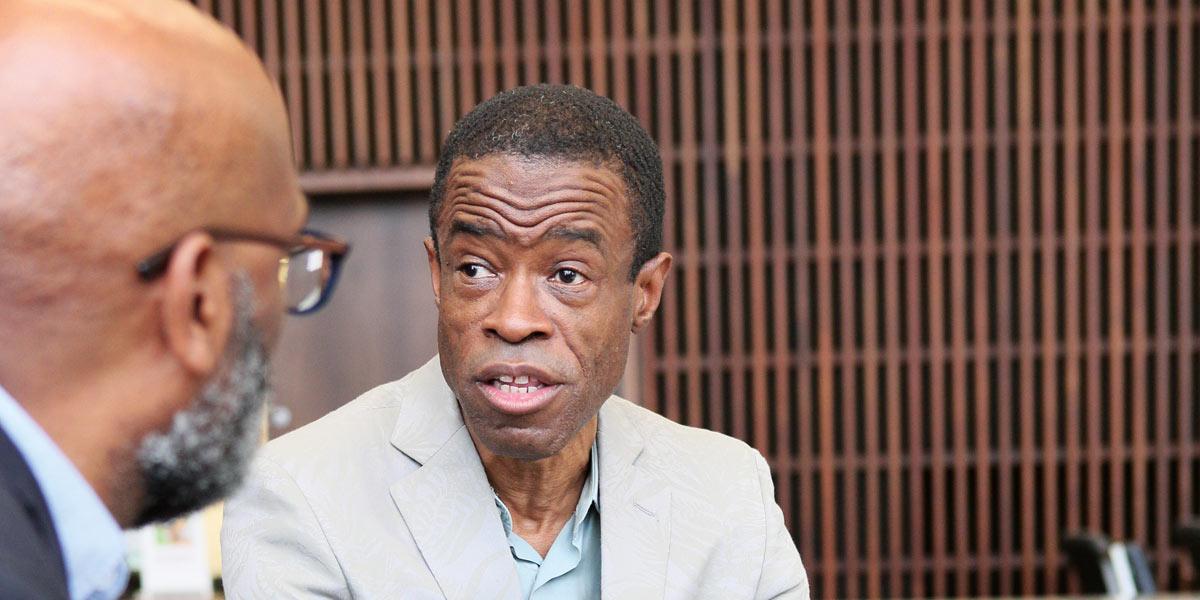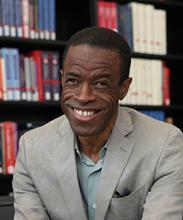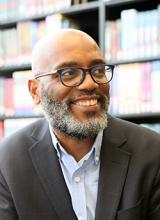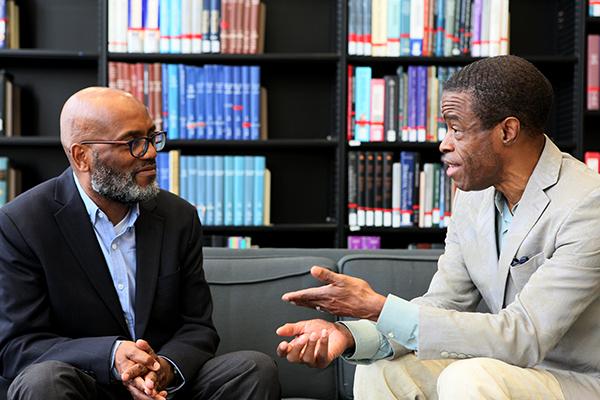Why Black Lives Matter
Scholars help educate about structural and environmental barriers
VOLUME 23 | ISSUE 1 | WINTER 2016
SSA associate professor Waldo E. Johnson, Jr., PhD ’93, and David J. Pate, Jr., AM ’82, associate professor at the Helen Bader School of Social Welfare at the University of Wisconsin-Milwaukee, recently met for a conversation about their research collaborations and collective work.

Their contributions to academic scholarship as well as to intervention and policy practice with black males, specifically adolescents through adults, have indirectly contributed to many of the ideas voiced by activists in the Black Lives Matter movement. They also discussed why it is critical to teach the lessons of the movement to social work students.
Johnson is an expert on African American males, specifically the development of young boys and adolescents, and how services provision to young fathers affects their physical and psychological well-being. He has examined the physical and mental health statuses of disconnected African American males on Chicago’s South Side in 34 community areas served by University of Chicago Medicine.


Pate is an expert on low-income African American men, fatherhood, and child support. He studies how black men are affected by the social welfare system and the challenges that impede their ability to attain economic security. His research projects, like Johnson’s, often involve the use of qualitative research methods to examine life course events of non-custodial African American men. This includes their ability to be gainfully employed, engage with their children, and sustain a good quality of life.
This portion of the Conversation appears in the print issue of the Winter 2016 SSA Magazine.
Johnson: When you and I, along with our colleague, Jarvis Givens at Berkeley, deconstructed what happened in the Derrion Albert beating death in our book chapter, “Big Boys Don’t Cry, Black Boys Don’t Feel,”* it appeared that four angry young black males randomly jumped Derrion after school and simply went berserk. But our broader, systematic examination revealed that the origins of this murder lie beyond the events of that day.
There were other structural and environmental factors in addition to the individual actions of those who struck the fatal blow. Derrion’s demise must be viewed in the light of tensions between Chicago’s contested neighborhoods and the Chicago Public Schools’ board decision to convert one of two local high schools into a military academy, which by default, positioned the second school as the sole neighborhood high school. In addition, Derrion’s community no longer had an economic base due to devastating socioeconomic changes.
As we reported, many of these young males were involved in an on-going turf battle with other males from the adjacent neighborhood. If you inquired why they were at war or even at odds with one another, few could offer an explanation. We realized that this unfortunate death was not solely about bad youth doing bad things but that it was also about the convergence of individual behaviors in response to structural and environmental inequities which included failed schools, housing, economic and work policies, and how these and other issues affect disconnected families and neighborhoods.
Opportunities are limited for constructing healthy masculinity within communities experiencing such severe economic hardship. Youth violence is a destructive but anticipated response to structural and environmental disorganization.
Pate: There is no real appreciation for the amount of “toxic stress” that low income black people live under on a daily basis in these neighborhoods. People just want to be safe and be recognized for their humanity. The Black Lives Matter movement has reinforced why I do what I do as I need to give voice to black males because no one is recognizing that people are screaming for help.
Many black families are under daily surveillance from the child welfare, child support, and corrections systems. This may be unintentional, or discriminatory, but it is this consistent surveillance that can lead to incarceration or other harm to men and their families.
Even though the social worker is supposed to go out there and engage in a manner that “makes it all better,” that sometimes is literally impossible because it requires a government sponsored social welfare program to assist in the facilitation of social justice. In 2011, I was invited by a law firm involved in a US Supreme Court case that was representing a man who had been incarcerated for non-payment of child support. This particular man was in jail for a whole year until he was able to make a purge payment for child support.
I’m sure that you’ve seen similar situations.
Johnson: Right. In fact, I am in discussion with an organization that’s interested in conducting a pilot evaluation of a program designed to re-engage incarcerated fathers with their children and families prior to release.
Men who are both in jail (because they are unable to pay their bonds) and men who are approaching release from prison and ex-offender status have similar but also different needs and service requirements. Social work interventions with jail detainees need not necessarily be as restrictive as ones with prisoners who are approaching ex-offender status. It’s important to recognize the fact that being in the county jail and having extended stays, in large measure, is more about their inability to pay a bond. Targeted reunification intervention strategies are needed for both jail detainees and incarcerated men.
But while jail detainees may not have been charged or found guilty of a detainable offense, they too bear the mark of a criminal. We need to help potential employers, among others in society, to understand the nuanced difference between being in jail simply because a man awaiting trial didn’t have money to make bond versus being a convicted felon so that the bar for employment consideration is properly adjusted. This recognition would substantially reduce the growing population of those who are unable to find employment to support themselves and their families because of the mark of a criminal record. Reunification not only could have potential benefits for their children’s orderly growth and development but also might reduce recidivism by enhancing the men’s employment and housing stability.
Pate: That mark of a criminal. It’s well documented in the academic literature that, particularly for black men, whether you’ve been charged or not charged, it means your chances of employment are slim to none.
Johnson: There are certain kinds of expectations, such as personal responsibility, that society holds for these men that is unmatched by society’s commitment to them given their evolving social statuses and wellbeing from boyhood to adulthood. As a society, we must look very closely to ensure that responsibility is not just individually framed and whether certain structures exist that contribute to their weakened statuses as boys and young men of color. This is what Black Lives Matter means and indeed social work can play a central role in advocating and working toward a just society in which black lives, like all lives, matter.

Pate: In that context, what could be the role of social work? Black Lives Matter gives a great opportunity, particularly in schools of social work, to raise consciousness about why it makes a difference to talk about a terminology such as “Black Lives Matter” and to deconstruct it for students. In my university, I have a lot of students who don’t have much contact with people of color. For them it’s hard to even understand what it really means. “Are you saying that I don’t matter?” they say. What we’re saying is, as a social worker, it is your responsibility to appreciate and understand why this is important at this particular moment in time. It’s not new.
Johnson: Black Lives Matter is not designed to discredit the value of other lives, as all lives do matter. The zero-sum perspective that often characterizes the racial inequality discourse in America implies that if we affirm one, it means that some other group is suddenly of no importance. This serves us poorly, is self-defensive in nature, and is a barrier that stifles a much needed broader discourse about societal inequities experienced in the lives of many groups, not just blacks.
Pate:The other thing I like about the Black Lives Matter movement, and particularly for teaching, is that it brings together everybody. It brings together the LGBT community and those who are hetero-normative; the health sector and the social welfare policy sector. I’ve been trying to get students to see this because three queer black women founded the Black Lives Matter movement in 2013 as a national organizing campaign. I make a point to make sure students understand that it’s not one segment of the population. We’re all saying—however we identify ourselves—to bring some humanity, compassion, and justice to the conversation.
*Johnson, Jr., Waldo E., David Pate, Jr., and Jarvis Givens. 2010. “Big Boys Don’t Cry, Black Boys Don’t Feel: The Intersection of Shame and Worry on Community Violence and the Social Construction of Masculinity among African American Males—The Case of Derrion Albert.” In Changing Places: How Communities Will Improve the Health of Boys of Color, edited by Christopher F. Edley, Jr., and Jorge Ruiz de Velasco. Berkeley: University of California Press.
The following web-only content is the continuation of professors Johnson and Pate's conversation.
Johnson: The conversation on the status of young males of color in the last three to five years, particularly on black males, has now permeated the media and is firmly ensconced in the public discourse. Some of the discussion focuses on violence among these young males. There is also discussion about young males of color, primarily black, who have been victimized by police and authority figures in a string of unfortunate deaths during police and law enforcement interactions. As a social work researcher and practitioner, how do you envision the Black Lives Matter movement in the realm of social work?
Pate: I remember my very first SSA field placement was working with middle school age black males in Woodlawn. I was placed there to mentor black boys to stay in school and perform well. It was during this first field placement that I learned there weren’t a whole lot of services for males.
This idea of Black Lives Matter began, at least for me, when I was a SSA student because working with young boys and black men became important around this time as people were looking at ways to engage males in the reduction of infant mortality and teenage pregnancy in Chicago. But what I found was that there was a lack of humanity and compassion for this one segment of society. What I learned as I was being trained as a social worker was to appreciate that you needed to be an advocate and I wanted to challenge this missing link. I needed to give voice to the voiceless.
During my first eight years of professional social work, I primarily provided direct services with young men around health and sex education services, perinatal counseling for low-income fathers, how to be an involved parent, and how a parent deals with infant mortality.
I learned from participating in these various jobs that there needed to be more interrogation of society’s commitment to supporting people. I started to question … when we say we’re providing people opportunities, do men really have those choices when they’re black and male? I didn't fully understand what it was about because I wasn’t a trained academic at that time. I thought, maybe it’s time for me to move into the policy realm to figure out where I could make a difference in that space.
Johnson: My anecdotal practice experiences suggested that the involvement of unwed fathers with their children was greater than the current empirical evidence documented. As a doctoral student, SSA challenged me to rethink in my dissertation the ways that unwed fathers are typically viewed as non-involved.
Pate: The “responsible father” thing…
Johnson: That's right, respectability among fathers. I began to examine how married fathers interacted with their kids and sought evidence whether those kinds of activities and behaviors were also present among unmarried fathers both living and not living in the household. I sought to socially construct a “father” parenting world that people did not often get an opportunity to see because the moms or the social workers were not around to document it.
Pate: I have to really applaud President Obama for being the first president to go into a federal prison and talk to prisoners. No president has ever done that. He’s recognizing some real issues that men are facing—particularly men of color—because he does have an interest in fathers being responsible. He recognizes the importance of men being engaged with their children.
Johnson: I, too, applaud the president’s decision to engage inmates in prison. His actions have informed my own thinking about responsible fatherhood within a much broader context, one in which all of the responsibility is not lodged with the fathers themselves.
I’m currently examining the social experiences of pre-adolescent and adolescent males as their paternal identities are evolving. Also, I examine masculinity construction within the environmental context—within a family context, a neighborhood context—and how the social construction of masculinity could potentially determine whether or not this sixteen-year-old male becomes a father versus another sixteen-year-old male who interacts and engages the masculinity construct differently in a way that delays fatherhood.
My decision to pursue a PhD coincided during my practice work that focused on teen pregnancy prevention with young males, which is when I first met you, and I realized that as long as there were other people outside of the social work profession calling the shots with respect to policy, social work would fail to turn the corner on the profession’s most pressing commitments. I really felt as if I could advocate. So it seemed to me, in order to affect change, we needed evidence. I thought, who better than social workers given our training? I began to think perhaps doctoral study will enable me to do that.
Pate: You’ve had to be very careful around certain professionals about how you present yourself when you're talking about men. Society is not very forgiving about what men may have or may have not done in their parenting role as well as the idea of not being responsible.
Johnson: Yes. My work tried to not only help fathers who may be experiencing some difficulties in terms of engaging with their kids but also being able to demonstrate the degree to which there were aspects of their involvement that were undocumented because they were either unmarried or not living in the household with the kids. I became very aware of the fact that there were individuals and groups who took great offense. To do this kind of advocacy on behalf of a segment of the population that were men—often very disadvantaged men—but just men in general suggested that I was in some ways trampling upon women, and particularly mothers who were struggling. At the same time I came to recognize that the mothers who were involved in relationships with these men were not nearly as sour or angered as some of the advocates. That also gave me some of the fortitude that I needed to continue to push forward.
Pate: I founded, in 1995, the Center for Family Policy and Practice currently based in Madison, WI under the leadership of Jacquelyn Boggess. The Center has been looking at domestic violence and fatherhood work for quite some time. One thing the center director will say is that women are really supportive of wanting men to get services. They want things that will make the community safer and the men less violent. They feel that the men are frustrated because they don't have any services: they just want a job, to take care of their kids and be able to live comfortably. We don’t have a whole lot of social welfare policies that will allow that to happen. There’s nothing for men around housing. They can get SNAP benefits (food stamps), but you need more than just to eat. You need to have a place to sleep and live and to be able to have some agency. The current definition of manhood is still rigidly defined as a breadwinner and being self-sufficient, which can be a crippling and demoralizing position for many poorly educated men of color. A lot of black men can’t be in that space.
John Rich of Drexel University wrote a book, Wrong Place, Wrong Time: Trauma and Violence in the Lives of Black Men that is very appropriate for this discussion. He simplifies the whole idea by saying, “hurt people, hurt people.” I always think about that now when I’m working with men because we don't recognize that they have some issues they’re walking around with that are unresolved. That’s why; again, the Black Lives Matter movement is so important right now for the work we’re doing and for what I have seen over the last thirty years.
Johnson: I agree. I think the social construction of masculinity among many of these young men is enacted in ways that clearly mask the hurt they feel broadly. The inability to be able to talk about—hat I’m hurt by what happened even though this is something that happened some time ago—and the inability to be able to confront those who may have been the perpetrators of the hurt has contributed to a lot of what now feels like an ‘eye for an eye’ response on the part of so many individuals. But, even in this context, all too often the most recent victim is not necessarily the perpetrator.
Pate: Exactly. I once talked with a man who taught his son from two years of age how to fall on the ground when he heard gunshots in his community. He said to me that it made him think that he was short-changing his own life because now he’s decided that this is normal; this is ok. But he should be madder than hell and say that this is not good. I think that’s what Black Lives Matter gives us a chance to do as a society: to say that this current killing of unarmed black men and women is unacceptable for everybody and that we are losing out on the person who may discover how to solve AIDS or build a bigger building, or faster planes. We haven’t allowed them to self-actualize as they’re living under such stress on a regular basis. I think there’s a great opportunity for social work schools to be engaged in a conversation on what is acceptable in a community.